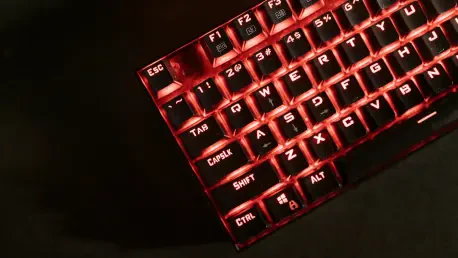In the fast-paced world of PC gaming, the allure of high-end gear has long been a towering aspiration for enthusiasts who crave the ultimate experience in performance and aesthetics. However, the hallmark of such technology—steep prices—often poses a formidable barrier. Yet, recent market trends suggest a shift towards making premium equipment much more accessible. With significant deals unfolding across various components like laptops, keyboards, mice, and graphics cards, the gaming landscape is evolving. Manufacturers are now focusing on delivering advanced technology at compelling prices, aligning with a consumer base that values both performance and affordability. This shift not only reflects a strategic rebalancing of features and cost but also speaks to a broader democratization of advanced technological assets within the gaming sphere. Delving into this phenomenon helps us understand how economic accessibility paired with technical innovation is reshaping the gaming industry’s competitive edge.
Innovations in Gaming Laptops
The world of gaming laptops has seen a marked evolution, largely driven by strategic moves from manufacturers that emphasize better value for consumers. Take the Alienware x16 laptop, for instance. As a game-changer in its own right, this model introduces CPU upgrades without inflating its entry-level price. Such maneuvers signify a trend where consumers can access top-tier specifications without breaching their financial limits. This approach allows for an expansion in gaming possibilities, providing users with machines that meet high-performance benchmarks while remaining economically viable. By focusing on optimizing existing price structures rather than escalating them, brands like Alienware are meeting a surging demand for high-efficiency, cost-effective gaming solutions. This strategy is in sync with an evolving market that prioritizes both state-of-the-art technology and consumer-friendly prices, reflecting a dynamic change in priorities that underpins the gaming industry’s product development philosophy.
Beyond CPU enhancements, the realm of gaming laptops is witnessing a paradigm where features synonymous with luxury goods are now standard. This includes aspects like high-refresh-rate displays and improved thermals, which were once exclusive to the highest price brackets. These features bridge the gap between price and quality, ensuring that the gaming experience isn’t compromised due to affordability constraints. It exemplifies a broader industry movement toward integrating premium aspects into mainstream models, thus broadening consumer access to enhanced gaming technology. By reevaluating pricing dynamics and integrating complex features at unchanged costs, manufacturers are paving the way for a future where access to high-caliber gaming gear is no longer a privilege for the few but a norm for the many. This approach mirrors a responsiveness to consumer needs where performance and price are harmoniously balanced, setting new standards across the gaming hardware landscape.
The Rise of Peripherals
While laptops take center stage in the gaming hardware discussion, peripherals like keyboards and mice are crucial components that define the gaming experience’s precision and comfort. Leading players in this sector, such as Logitech, Razer, and Corsair, continue to enrich their offerings with cutting-edge innovations. The introduction of wireless capabilities, rapid trigger switches, and modular designs signifies a robust trend towards adaptability and customization. Such advancements underscore a strategic emphasis on creating peripherals that cater to specific user preferences while maintaining optimal performance standards. These trends point towards a broader industry insight: the increasing acknowledgment of ergonomics and responsiveness as vital factors in product appeal and functionality. By enabling a more tailored user experience, these brands contribute to a gaming environment where peripherals are not only accessorized enhancements but pivotal to gameplay efficiency and satisfaction.
Furthermore, top-tier peripherals now offer pro-level responsiveness, a feature once reserved for professional e-sports tournaments, but now accessible to the everyday gamer. This democratization of technology ensures that the broader gaming community benefits from advancements designed to enhance competitive gaming dynamics. The convergence of customization with performance reveals an industry pivot towards sustaining high user engagement through innovation. Such innovations also reflect a commitment to remaining attuned to evolving gamer expectations, validating that peripherals can have a profound impact on the overall gaming experience. This market shift highlights the necessity for peripherals that don’t just accompany gameplay but are integral to achieving consistent, high-performance results. The focus on user engagement and tailored functionalities signals a pivotal moment in peripheral development, as brands seek to redefine gaming interaction parameters to offer unrivaled engagement and satisfaction.
Transformative Graphics Card Developments
The graphics card sector, a cornerstone of gaming hardware, is experiencing transformative developments marking significant leaps in both power and efficiency. Graphics cards such as the RTX 5090 series set a new benchmark with their introduction of 32GB of ultra-fast GDDR7 memory, which significantly elevates the gaming experience to support resolutions of 4K and 8K. This remarkable enhancement caters to a growing appetite for visually stunning and immersive gaming landscapes. It reflects the industry’s continuous push towards achieving graphical excellence—a pursuit that defines competitive gaming environments today. The integration of these robust advancements signifies a definitive stride towards meeting consumer demands for high-fidelity gaming experiences while maintaining competitive pricing strategies. By aligning technological prowess with consumer affordability, brands are effectively broadening the appeal of graphical upgrades to a more economically diversified audience.
In tandem with memory and interface leaps, innovations in cooling systems by brands like MSI, ZOTAC, and PNY also illuminate noteworthy progress. Implementations of advanced cooling technologies ensure that high-performing graphics cards maintain optimal performance levels without overheating—a critical factor in safeguarding the longevity and reliability of hardware. This dedication to thermal efficiency not only increases the operational endurance of gaming systems but also enhances user satisfaction by promising sustained performance under intensive use. These developments showcase a commitment to pushing the envelope in creating balanced devices that reflect a synergy between performance demands and heat management. By addressing heat dissipation concerns alongside potent graphical capabilities, manufacturers successfully enhance the reliability and appeal of their products. This focus on delivering balanced enhancements accentuates an effort to ensure that cutting-edge graphical experiences are sustainable, efficient, and widely accessible within the gaming community.
Economic Accessibility and Market Trends
A notable trend in the gaming hardware landscape is the increasing emphasis on value perception as a strategic driver of consumer acceptance. Discounts on gaming equipment, which range from modest cuts to substantial reductions, are ushering in a market landscape where technological superiority is paired with economic sensibility. This shift towards affordability reflects a broader initiative to democratize access to high-quality gaming tools, making them attainable across diverse financial backgrounds. The emphasis on offering competitive pricing in conjunction with advanced features points towards a growing recognition among manufacturers of the diversity within the gaming community, whereby various levels of financial capacity are addressed, allowing a more inclusive market participation.
As companies begin to embrace this pricing strategy, advanced gaming tools are no longer perceived solely as luxury goods but as attainable products accessible to a wider audience. This democratization of gaming hardware reshapes market dynamics, potentially expanding market inclusion and fostering growth avenues within previously underserved segments. The move towards affordability without compromising on quality reflects a paradigm shift among manufacturers, signifying an acknowledgment of consumer needs that go beyond mere technological innovation. It embodies a strategic balance where economic accessibility and advanced technical performance are equally prioritized, enhancing appeal and acceptance among a broader consumer base. This alignment of performance, affordability, and accessibility underscores the dynamism reshaping gaming hardware, ensuring that high-quality experiences are within reach for a myriad of users worldwide.
Conclusion: Balancing Performance and Affordability
Gaming laptops have witnessed notable advancement, driven by makers who focus on delivering greater value. The Alienware x16 laptop serves as a prime example, offering CPU upgrades without hiking its base price. This trend allows consumers to access high-end specs without financial strain, expanding gaming possibilities with machines that achieve performance excellence while remaining affordable. Brands like Alienware are responding to a growing demand for efficient and budget-friendly gaming solutions by optimizing price structures. It aligns with a market shift that emphasizes cutting-edge tech coupled with consumer-friendly costs, revealing a shift in priorities shaping the gaming industry’s development philosophy.
Beyond CPU improvements, gaming laptops now feature elements once exclusive to luxury models, such as high-refresh-rate displays and superior thermals, bridging the gap between price and quality. The industry is moving towards integrating premium features into standard models, enhancing consumer access to advanced tech. By rethinking pricing and incorporating complex features at stable costs, manufacturers are ensuring high-quality gaming tools are attainable, balancing performance and affordability.









